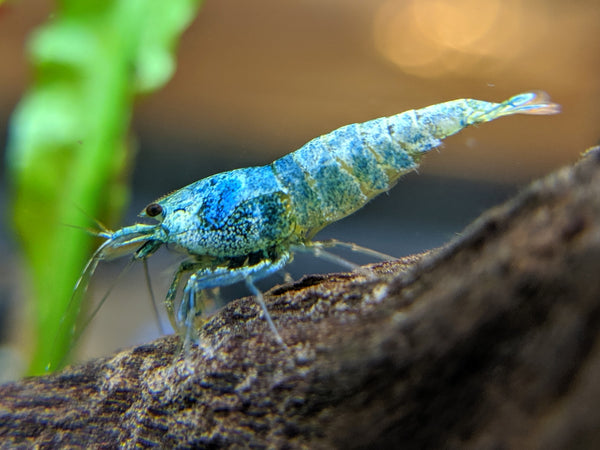Easily one of the most popular species of dwarf shrimp in the aquarium hobby, Taiwan bee shrimp (Caridina cantonensis) come in a wide array of colors. These beautiful shrimp are endlessly entertaining and are relatively easy to care for. Let’s explore the many Taiwan bee shrimp varieties.
Species Snapshot
-
Species Name: Caridina cantonensis
-
Common Names: bee shrimp, Taiwan bee shrimp
-
Size: 0.75 to 1.25 inches
-
Lifespan: 1 to 2 years
-
Native Distribution: Taiwan
The bee shrimp, or Taiwan bee shrimp, is a species of freshwater dwarf shrimp that grows up to about 1.25 inches in length. As their name suggests, this species is native to Taiwan where it can be found in crystal clear streams. Though still common in the wild, the bee shrimp sold in the aquarium hobby are largely captive bred. Interestingly, several of the newest variants are all the result of a genetic mutation.
The exact origins of the bee shrimp are unclear, but many breeders suggest that the species’ popularity started to climb in the 1990s thanks to Hisayasu Suzuki. A prolific Japanese breeder of freshwater dwarf shrimp, Suzuki is credited with the development of the crystal red shrimp from a handful of black bee shrimp that exhibited a slight reddish hue. Over time, Suzuki and others selectively bred the species to enhance its red and white striped pattern.
Along a similar vein, Taiwan bee shrimp were developed from crystal bee shrimp that exhibited a genetic mutation. The name Taiwan bee shrimp applies specifically to several variants with this mutation such as blue bolt, black King Kong, and ruby red.
5 Taiwan Bee Shrimp Variants
Taiwan bee shrimp are some of the most attractive specimens in the aquarium hobby. Depending on breeding, they can be found in blue, red, black, and even green. Here is an overview of five popular Taiwan bee shrimp variants.
-
Blue Bolt
These shrimp range from brilliant aquamarine to intense royal blue coloration. They’re graded according to intensity and opacity of their color, just like crystal red shrimp. High-grade blue bolt shrimp exhibit consistent sky-blue color all over their bodies.

-
Wine Red
This variant is very similar in appearance to the crystal red shrimp. It has a deep wine-red coloration that is much more intense than the red on crystal red shrimp. They can also be distinguished by their heads being red rather than white.
-
King Kong
Unlike the previous two variants, King Kong shrimp are not colorful — they are almost all or completely black. Some specimens exhibit small white markings.
-
Ruby Red
Bright red in color, ruby red Taiwan bee shrimp exhibit all-over coloration with no to little white marking on their heads, backs, and tails. Ruby red Taiwan bee shrimp are selectively bred from wine red shrimp to have more red coloration.
-
Panda
Similar to King Kong shrimp, the panda variety of Taiwan bee shrimp is black. The difference is that panda shrimp have more white, typically seen in bands around the lower half of the body and on the head. There is also a shadow panda variant which has light blue bands instead of white.
Caring for Taiwan Bee Shrimp
Because Taiwan bee shrimp varieties were all developed from a group of highly selected crystal bee shrimp, there is a great deal of inbreeding within the species. These shrimp are more prone to genetic defects than other dwarf shrimp, and they are often smaller as well. Their care requirements are very similar to other Caridina dwarf shrimp, but they may be a little more sensitive. As such, Taiwan bee shrimp may not be the best choice for inexperienced hobbyists.
Taiwan bee shrimp require very clean water and are best kept in established planted aquariums. Though peaceful by nature, these shrimp generally do best in shrimp-only tanks with others of the same species. Keeping a single variety also prevents breeding between different genetic strains.
Breeders of Taiwan bee shrimp suggest that the species does better in temperatures slightly cooler than other dwarf shrimp prefer. The ideal temperature range is 68°F to 74°F. You may be able to keep them in warmer temperatures, but tanks kept above 74°F will require an air stone to ensure proper oxygenation of the water. In terms of other water parameters, Taiwan bee shrimp prefer soft, slightly acidic water.
Feeding Taiwan bee shrimp is no different from other freshwater dwarf shrimp. They are scavengers that will feed on anything they find in the tank from algae to biofilm. Depending on the size of your tank and how many shrimp you keep, you may need to offer supplemental food sources like shrimp pellets, algae wafers, or blanched vegetables from time to time.
Breeding Taiwan Bee Shrimp
Because all Taiwan bee shrimp are the same species, Caridina cantonensis, it’s important to separate the strains if you want to preserve their appearance. Breeding different strains won’t technically produce a hybrid shrimp, but the resulting shrimp are unlikely to be as attractive as either of the parents.
While there are some challenges involved with separating different strains of Taiwan bee shrimp, they are no more difficult to breed than other dwarf shrimp. Mature shrimp will breed readily when kept in proper conditions. Adult females will produce pheromones after molting that attract male shrimp. Once the eggs are laid and fertilized, the female shrimp collect them and hold them in clusters on the underside of their tail.
Once hatched, the baby bee shrimp are self-sufficient. They look like mini replicas of adult shrimp and require the same diet and tank conditions. With enough food and clean water, it shouldn’t be difficult to achieve a high survival rate.
